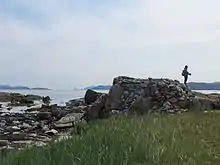James A. Tuck, ONL FRSC (June 28, 1940[1] – May 10, 2019) was an American-born archaeologist whose work as a faculty member of the Memorial University of Newfoundland was focused on the early history of Newfoundland and Labrador.
Career
Tuck was born in Buffalo, New York in 1940;[1] he received a doctoral degree from Syracuse University.[2] He subsequently began teaching and practicing archaeology as a faculty member at Memorial University of Newfoundland.[3] Since the late 1960s, Tuck focused his archaeological work in Newfoundland and Labrador.
His early work included unearthing the Maritime Archaic burial ground at Port au Choix. From 1977 until the late 1980s he excavated the sixteenth century Basque whaling station at Red Bay Labrador.
Starting in 1969 he led teams that excavated Inuit graves on Rose Island which is now in Torngat Mountains National Park.[4][5] which is viewed by the local Inuit as a desecration and robbery. This led to the remains of 113 Inuit – 100 from Rose Island and 13 from Upernavik Island being repatriated and reburied in a common grave in 1995. A further 11 Inuit remains were repatriated in a special ceremony on August 16, 2011, attended by the Honourable Kathy Dunderdale, Premier of Newfoundland and Labrador, and Nunatsiavut President Jim Lyall.[6]

Since the late 1980s, Tuck worked on unearthing the Province of Avalon located at Ferryland. To date the dig has found and catalogued over two million artifacts from the 4-acre (16,000 m2) site.
Tuck was a supporter of Patricia Sutherland's controversial theory[7][8][9] that there was European contact with the Dorset on Baffin Island, Canada, hundreds of years before the Norse started settling in Greenland in 985 CE.[10] He died on May 10, 2019, at the age of 79 at Martha's Vineyard Hospital in Oak Bluffs, Massachusetts.[11][12]
Awards
- 1982 elected to fellowship in the Royal Society of Canada
- 2004 awarded the Order of Newfoundland and Labrador[3]
- 2009 awarded The Smith-Wintemberg Award by the Canadian Archaeological Association
References
- 1 2 Juanita Mercer (June 19, 2019). "Late archeologist Jim Tuck's family recounts fond memories, considers museum in Ferryland". The Telegram. Retrieved February 10, 2020.
- ↑ Tuck, James A. from the Library of Congress Name Authority
- 1 2 Recipient biography Archived 2007-02-17 at the Wayback Machine at Order of Newfoundland and Labrador, Government of Newfoundland and Labrador
- ↑ Tuck, James 1975 Prehistory of Saglek Bay, Labrador: Archaic and Palaeo-Eskimo Occupations. Archaeological Survey of Canada Mercury Paper No. 32. National Museum of Man, Ottawa.
- ↑ ARCTIC VOL. 33, NO. 3 (SEPTEMBER 1980). P. 585 - 606 Preliminary Report on the Torngat Archaeological Project
- ↑ Labrador Inuit Land Claims Agreement - April 1st, 2011 - March 31st, 2012
- ↑ Weber, Bob (22 July 2018). "Ancient Arctic people may have known how to spin yarn long before Vikings arrived". Old theories being questioned in light of carbon-dated yarn samples. CBC. Retrieved 2 January 2019.
... Michele Hayeur Smith of Brown University in Rhode Island, lead author of a recent paper in the Journal of Archaeological Science. Hayeur Smith and her colleagues were looking at scraps of yarn, perhaps used to hang amulets or decorate clothing, from ancient sites on Baffin Island and the Ungava Peninsula. The idea that you would have to learn to spin something from another culture was a bit ludicrous," she said. "It's a pretty intuitive thing to do.
- ↑ Barber, Elizabeth Wayland (1992) Prehistoric Textiles: The Development of Cloth in the Neolithic and Bronze Ages with Special Reference to the Aegean, Princeton University Press, "We now have at least two pieces of evidence that this important principle of twisting for strength dates to the Palaeolithic. In 1953, the Abbé Glory was investigating floor deposits in a steep corridor of the famed Lascaux caves in southern France [...] a long piece of Palaeolithic cord [...] neatly twisted in the S direction [...] from three Z-plied strands [...]" ISBN 0-691-00224-X
- ↑ Smith, Michèle Hayeur; Smith, Kevin P.; Nilsen, Gørill (August 2018). "Journal of Archaeological Science" (PDF). Dorset, Norse, or Thule? Technological Transfers, Marine Mammal Contamination, and AMS Dating of Spun Yarn and Textiles from the Eastern Canadian Arctic. Elsevier. doi:10.1016/J.JAS.2018.06.005. hdl:10037/14501. S2CID 52035803. Archived from the original (PDF) on 2019-01-13. Retrieved 12 January 2019.
However, the date received on Sample 4440b from Nanook clearly indicates that sinew was being spun and plied at least as early, if not earlier, than yarn at this site. We feel that the most parsimonious explanation of this data is that the practice of spinning hair and wool into plied yarn most likely developed naturally within this context of complex, indigenous, Arctic fiber technologies, and not through contact with European textile producers. [. . .] Our investigations indicate that Paleoeskimo (Dorset) communities on Baffin Island spun threads from the hair and also from the sinews of native terrestrial grazing animals, most likely musk ox and arctic hare, throughout the Middle Dorset period and for at least a millennium before there is any reasonable evidence of European activity in the islands of the North Atlantic or in the North American Arctic
- ↑ Armstrong, Jane (20 November 2012). "Vikings in Canada?". A researcher says she's found evidence that Norse sailors may have settled in Canada's Arctic. Others aren't so sure. Maclean's. Retrieved 15 January 2019.
In fact, Fitzhugh thinks the cord at the centre of Sutherland's "eureka" moment is a Dorset artifact. "We have very good evidence that this kind of spun cordage was being used hundreds of years before the Norse arrived in the New World, in other words 500 to 600 CE, at the least," he says.
- ↑ "James A. Dr. Tuck Obituary - Visitation & Funeral Information".
- ↑ "Pioneering MUN archeologist Jim Tuck dies at 79". CBC News. 2019-05-14. Retrieved 2019-05-14.